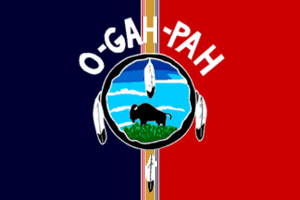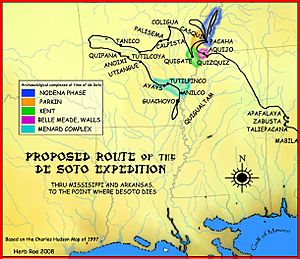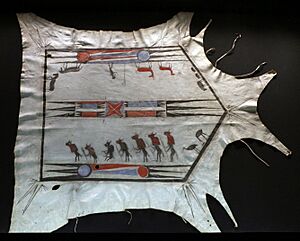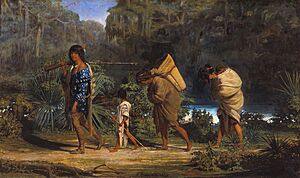Quapaw facts for kids
| Ogáxpa | |
|---|---|

Flag of the Quapaw Nation
|
|
| Total population | |
| 3,240 | |
| Regions with significant populations | |
| Languages | |
| English, Quapaw | |
| Religion | |
| Christianity (Catholicism), traditional tribal religion, Big Moon and Little Moon Native American Church | |
| Related ethnic groups | |
| Dhegihan peoples: Osage, Omaha, Ponca, Kansa |
The Quapaw (pronounced KWAW-paw) or Arkansas people are also known as the Quapaw Nation. This is a U.S. federally recognized tribe. It has about 5,600 members.
The Quapaw call themselves Ogáxpa, meaning "Downstream people". Their original homelands stretched from the Ohio River to the Mississippi River. This area included parts of present-day Arkansas and Oklahoma. In 1834, the U.S. government forced them to move from Arkansas Territory. Today, their main tribal office is in Quapaw, Oklahoma.
Contents
What's in a Name?
The Quapaw were first called Akansa by Algonquian-speaking people. This word meant "People of the South Wind." French explorers learned this name and changed it to Arcansas.
The French then named the river and a trading post after them. When the tribe moved down the Mississippi River, they became known as Quapaw (Ogáxpa). This name means "Downstream people."
Other old spellings for the tribe included Acansa and Acansea.
A Look at Quapaw History
Early Days (Before 1682)
The Quapaw people are descendants of a group called the Dhegiha. These people lived in the lower Ohio River valley. Other tribes like the Omaha, Ponca, Osage, and Kaw are also from this group.
It is believed that the Quapaw and other Dhegiha tribes moved west and south around 1200 CE. The Quapaw's own stories say they separated from the other Dhegiha tribes near where the Missouri and Mississippi Rivers meet.
The Quapaw reached their historic lands, near the confluence of the Arkansas and Mississippi rivers, by the mid-1600s.
In 1541, the Spanish explorer Hernando de Soto explored this area. He found a town called Pacaha. This town was strongly protected by a wall and a ditch. It is thought that de Soto might have met the Tunica there.
The first clear meetings between Europeans and the Quapaw happened over 130 years later. In 1673, French explorers Jacques Marquette and Louis Jolliet traveled down the Mississippi River. They met the Akansea (Quapaw) people. The Quapaw welcomed them warmly.
In 1682, La Salle also visited their villages. He made peace with the tribe and claimed the land for France. The Quapaw were known to be kind and friendly to the French.
Colonial Times (1682–1803)
In 1686, the French built a trading post near the Arkansas River. This post later became known as the Arkansas Post. This was the start of European settlement in Quapaw lands.
Around 1697, a smallpox epidemic caused many deaths among the Quapaw. In 1729, the Quapaw joined with French settlers to fight against the Natchez tribe.
After France lost the Seven Years' War, it gave its North American lands to Britain. Britain then traded some land with Spain. Spain took control of Arkansas and other former French lands west of the Mississippi River. The Spanish built new forts to protect their important trading post with the Quapaw.
Many French fur traders and explorers had good relationships with the Quapaw. Some French men and Quapaw women married and had families. Pine Bluff, Arkansas, for example, was founded by Joseph Bonne, who had both Quapaw and French heritage.
The 1800s
After the United States bought the land in 1803 (the Louisiana Purchase), the Quapaw lived in three villages. In 1818, the U.S. government recognized the Quapaw as the owners of a large area. This included most of present-day Arkansas and parts of Louisiana, Mississippi, and Oklahoma.
However, the Quapaw had to give up almost all of this land to the U.S. government. They kept a smaller area between the Arkansas and Saline Rivers. In return, the U.S. promised them money.
Under more pressure, in 1824, they gave up even this smaller area. They hoped to join the Caddo tribe in Louisiana, but the U.S. government said no. Floods in the Caddo lands caused many Quapaw to face starvation. They eventually returned to their old homes.
In 1834, because of another treaty and the government's Indian Removal policy, the Quapaw were forced to move again. They moved from the Mississippi valley to their current home in the northeast corner of Oklahoma. This area was then called Indian Territory.
The 1900s
By the early 1900s, the Quapaw population had greatly decreased. This was due to diseases, wars, and forced moves. In 1687, there were about 3,200 Quapaw. By 1910, their numbers were around 307, including people of mixed heritage.

Quapaw Economy
The Quapaw Nation owns and runs several businesses. These include two smoke shops and gas stations called Quapaw C-Store and Downstream Q-Store. They also own the Eagle Creek Golf Course and resort in Loma Linda, Missouri.
Their main source of income comes from their casinos. These include the Quapaw Casino and the Downstream Casino Resort, both in Quapaw, Oklahoma. These casinos bring in a lot of money for the tribe. This money helps support tribal members with health, education, and other needs. In 2012, the Quapaw Tribe's businesses added over $225 million to the local economy.
In 2020, they opened a third casino, Saracen Casino Resort, in Pine Bluff, Arkansas. This was the first casino built specifically for gambling in that state. It cost $350 million to build and employs over 1,100 people.
In the 20th century, the Quapaw leased some of their land for industrial use. Unfortunately, toxic waste was left behind, causing environmental problems. One example is the Tar Creek Superfund site. This area needs a lot of clean-up because of the pollution.
Quapaw People Today
Population
The Quapaw Nation has 3,240 enrolled members. Of these, 892 live in Oklahoma. To be a member of the tribe, you must be a direct descendant of a Quapaw person.
Language
The traditional Quapaw language is part of the Dhegiha branch of the Siouan language family. This language has been studied and recorded by many people over the years. Today, there are very few native speakers left.
The tribe is working hard to keep their language alive. In 2011 and 2012, the Quapaw hosted the Dhegiha Gathering. This event brought together the five related Dhegiha tribes to share language-learning methods. The tribe also offers Quapaw language classes at their tribal museum. They have even created an online audio dictionary using old recordings of elders speaking the language.
Culture and Community
The Quapaw Nation holds many cultural events throughout the year. Most of these events take place at the tribal museum. You can learn about traditional Indian dice games, singing, and arts like finger weaving and flute making. Language classes are also offered there.
The tribe's annual dance is held during the Fourth of July weekend. This dance has been happening for over 130 years! It includes different types of dances like the gourd dance, war dance, and stomp dance. Other activities at the event include Indian football, handgame, traditional footraces, and traditional dinners.
In Popular Culture
- The 2009 movie Tar Creek is about the Tar Creek Superfund Site on Quapaw lands. This film talks about the environmental problems there.
- In 2018, a documentary called The Pride of the Ogahpah was made. It shows how the Downstream Casino Resort, run by the Quapaw Nation, was developed.
Notable Quapaw People
- Louis Ballard, (1931–2007) a famous composer, artist, and teacher.
- Ardina Moore, a language teacher and artist who makes traditional clothing.
- Saracen, a war chief who received a special medal from the president.
See also
In Spanish: Quapaw para niños





